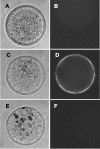Direct binding of the ligand PSG17 to CD9 requires a CD9 site essential for sperm-egg fusion
- PMID: 14528020
- PMCID: PMC284811
- DOI: 10.1091/mbc.e03-04-0244
Direct binding of the ligand PSG17 to CD9 requires a CD9 site essential for sperm-egg fusion
Abstract
The function currently attributed to tetraspanins is to organize molecular complexes in the plasma membrane by using multiple cis-interactions. Additionally, the tetraspanin CD9 may be a receptor that binds the soluble ligand PSG17, a member of the immunoglobulin superfamily (IgSF)/CEA subfamily. However, previous data are also consistent with the PSG17 receptor being a CD9 cis-associated protein. In the current study, CD9 extracellular loop (EC2) specifically bound to PSG17-coated beads, indicating a direct interaction between the two proteins. However, CD9-EC2 did not bind to PSG17-coated beads if the CD9-EC2 had the mutation SFQ (173-175) to AAA, a previously studied mutation in egg CD9 that abolishes sperm-egg fusion. Also, PSG17 bound to 293 T cells transfected with wild-type CD9 but not the mutant CD9. By immunofluorescence, PSG17 bound to wild-type eggs but not to CD9 null eggs. The presence of approximately 2 microM recombinant PSG17 produced a significant and reversible inhibition (60-80%) of sperm-egg fusion. Thus, we conclude that CD9 is a receptor for PSG17 and when the PSG17 binding site is mutated or occupied, sperm-egg fusion is impaired. These findings suggest that egg CD9 may function in gamete fusion by binding to a sperm IgSF/CEA subfamily member and such proteins have previously been identified on sperm.
Figures






Similar articles
-
CD9 protein appears on growing mouse oocytes at the time when they develop the ability to fuse with spermatozoa.Zygote. 2006 May;14(2):119-23. doi: 10.1017/S0967199405003497. Zygote. 2006. PMID: 16719947
-
Immunoglobulin superfamily member IgSF8 (EWI-2) and CD9 in fertilisation: evidence of distinct functions for CD9 and a CD9-associated protein in mammalian sperm-egg interaction.Reprod Fertil Dev. 2009;21(2):293-303. doi: 10.1071/rd08158. Reprod Fertil Dev. 2009. PMID: 19210920 Free PMC article.
-
Residues SFQ (173-175) in the large extracellular loop of CD9 are required for gamete fusion.Development. 2002 Apr;129(8):1995-2002. doi: 10.1242/dev.129.8.1995. Development. 2002. PMID: 11934865
-
Role of tetraspanin CD9 molecule in fertilization of mammals.Physiol Res. 2015;64(3):279-93. doi: 10.33549/physiolres.932876. Epub 2014 Dec 22. Physiol Res. 2015. PMID: 25536312 Review.
-
Sperm-egg interaction.Annu Rev Physiol. 2012;74:477-502. doi: 10.1146/annurev-physiol-020911-153339. Epub 2011 Nov 4. Annu Rev Physiol. 2012. PMID: 22054237 Review.
Cited by
-
Oocyte ERM and EWI Proteins Are Involved in Mouse Fertilization.Front Cell Dev Biol. 2022 Mar 14;10:863729. doi: 10.3389/fcell.2022.863729. eCollection 2022. Front Cell Dev Biol. 2022. PMID: 35359433 Free PMC article.
-
Functional interplay between tetraspanins and proteases.Cell Mol Life Sci. 2011 Oct;68(20):3323-35. doi: 10.1007/s00018-011-0746-y. Epub 2011 Jun 18. Cell Mol Life Sci. 2011. PMID: 21687991 Free PMC article. Review.
-
The immune-modulating pregnancy-specific glycoproteins evolve rapidly and their presence correlates with hemochorial placentation in primates.BMC Genomics. 2021 Feb 18;22(1):128. doi: 10.1186/s12864-021-07413-8. BMC Genomics. 2021. PMID: 33602137 Free PMC article.
-
Impaired cell adhesion, apoptosis, and signaling in WASP gene-disrupted Nalm-6 pre-B cells and recovery of cell adhesion using a transducible form of WASp.Int J Hematol. 2012 Mar;95(3):299-310. doi: 10.1007/s12185-012-1013-1. Epub 2012 Feb 5. Int J Hematol. 2012. PMID: 22311461
-
Tetraspanins: Small transmembrane proteins with big impact on membrane microdomain structures.Commun Integr Biol. 2008;1(1):11-3. doi: 10.4161/cib.1.1.6406. Commun Integr Biol. 2008. PMID: 19704780 Free PMC article.
References
-
- Allen, C.A., and Green, D.P. (1995). Monoclonal antibodies which recognize equatorial segment epitopes presented de novo following the A23187-induced acrosome reaction of guinea pig sperm. J. Cell Sci. 108, 767-777. - PubMed
-
- Beauchemin, N., et al. (1999). Redefined nomenclature for members of the carcinoembryonic antigen family. Exp. Cell Res. 252, 243-249. - PubMed
-
- Charrin, S., Le Naour, F., Oualid, M., Billard, M., Faure, G., Hanash, S.M., Boucheix, C., and Rubinstein, E. (2001). The major CD9 and CD81 molecular partner. Identification and characterization of the complexes. J. Biol. Chem. 276, 14329-14337. - PubMed
-
- Chen, M.S., Tung, K.S., Coonrod, S.A., Takahashi, Y., Bigler, D., Chang, A., Yamashita, Y., Kincade, P.W., Herr, J.C., and White, J.M. (1999). Role of the integrin-associated protein CD9 in binding between sperm ADAM 2 and the egg integrin alpha6beta1: implications for murine fertilization. Proc. Natl. Acad. Sci. USA 96, 11830-11835. - PMC - PubMed
Publication types
MeSH terms
Substances
Grants and funding
LinkOut - more resources
Full Text Sources
Other Literature Sources

